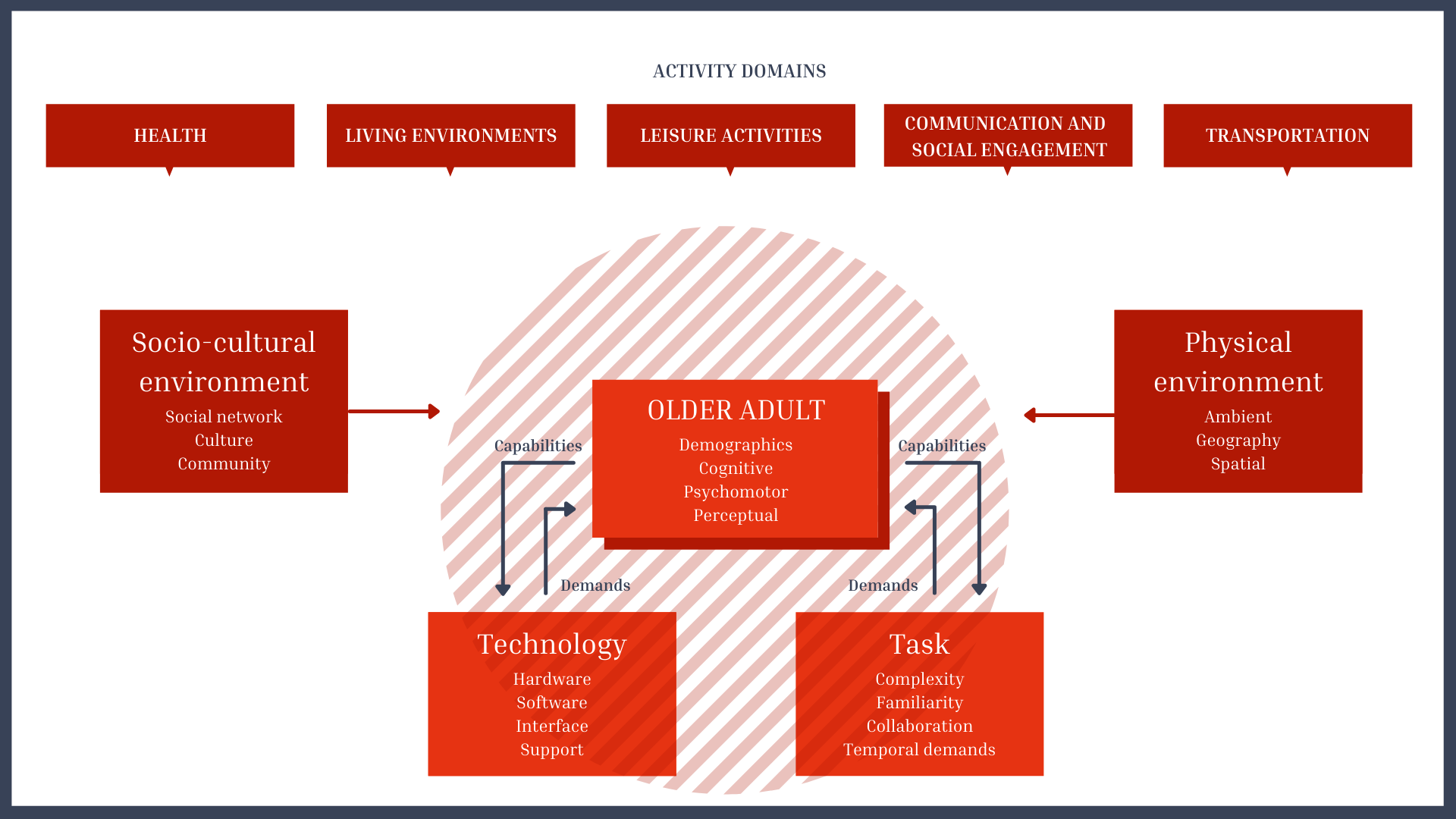
What is CREATE?
CREATE (The Center for research and education on aging and technology enhancement) is a multidisciplinary research center bringing together the best scientists in the field of "Human Factors, Aging and Technology". The studies conducted within this network focus on issues related to older people and their interactions with digital technologies. The success of this multidisciplinary approach is illustrated by contributions with a strong scientific and societal impact, and in particular, on issues related to the health of the elderly.
With an increasingly ageing population, this research topic has gained considerable momentum over the last few decades. For example, in 1960, 5% of the world's population was over 65 years old, compared to almost 9.3% in 2020, and forecasting models even indicate 16% in 2050 (source: UN world population prospect). In France, for example, 20.7% of the population will be over 65 in 2021 (source: Insee).
Technology is becoming omnipresent in daily life: work, learning, health, transportation, leisure... and the number of elderly people who are sometimes forced to use them is increasing drastically. The challenge of these research themes is all the more important as each person ages differently, this is what we call the interindividual variability of aging. Aging is a multidimensional process involving physical, psychological, social, environmental and often economic changes. The challenge is then to design technologies for the daily life of the elderly, which adapt to the variability of their needs, in order to be effective and accepted by the users.
Thus, CREATE strives to understand how the characteristics of the individual and his/her environment influence interactions with technology. CREATE also develops principles and methods to facilitate the design, implementation (deployment and support), and evaluation of emerging technologies (usability, user experience, and effectiveness of service delivery).
How does the CREATE model of technology design for older adults work?
One of the major contributions of CREATE is the systemic model of technology design. The model advocates the application of participatory design techniques in which all stakeholders must contribute equally (clinical experts, educators, families, targeted elderly, designers and developers).
In an original and comprehensive way, CREATE defends an eco-systemic approach (typical of the so-called "human factors" approaches) by emphasizing the importance of integrating into the design the influence of the cultural, social and physical environment, including in a proximal way the human environment or the type of habitat, and in a distal or latent way the organizations and the public policies of health and treatment of old age. At a more individual level, successful technology design depends on the fit between:
- the user's abilities, notably cognitive and physical, influenced by many factors, including age, functional status and health;
- the demands of the task, in cognitive and physical terms, also influenced by internal factors such as the complexity and familiarity of the task, or the context in which it is performed;
- the system interaction demands in terms of cognitive and physical resources, depending in particular on the hardware and software interface of the system.
According to this model, the more user-centered the design, the higher the ergonomic properties will be and the more positive the user experience of the technology will be, and its adoption facilitated (example of the PRISM1 study and the DomAssist2 solution). The strength of this model is its application to multiple domains of activity and social participation such as health, transportation, leisure, etc.
1 Czaja, S., Moxley, J., & Rogers, W. A. (2021). Social Support, Isolation, Loneliness, and Health Among Older Adults in the PRISM Randomized Controlled Trial. Frontiers in Psychology, 4307.
2 Consel, C., Dupuy, L., & Sauzéon, H. (2017, July). HomeAssist: An assisted living platform for aging in place based on an interdisciplinary approach. In International conference on applied human factors and ergonomics (pp. 129-140). Springer, Cham.
What are the areas of application of this model?
Predicting the future is easy, but making a correct prediction is difficult. Using the invariant identification heuristic, trends can be identified in digital technologies, characteristics of the elderly population, and environments. There is evidence of accelerating technology diffusion, but there are factors that may affect this trend, such as global warming, and in particular, energy conservation trends.
As people evolve slowly, delays in technology adoption by older populations are to be expected. For example, the trend toward miniaturization of products is problematic for older adult users, as is the IoT (Internet of Things), which offers both opportunities but more importantly challenges to support aging adults. An important issue to address in the coming years is privacy and security.
Also, positive environmental and cultural trends are observed in housing design, and health policies (health and medico-social structures supporting the elderly) to better cover the diversity of elderly populations. A good user-centered design is the key to register and orient these new trends to better include the elderly in our societies.
How are French researchers getinspired by this model?
Projects based on the CREATE model are springing up all over France. Here is a look at four projects in which French researchers are involved, presented at the CREATE workshop:
Personalized cognitive training for inter-individual variability in older adults
The effectiveness of cognitive training programs is now widely debated. One of the major problems is the lack of consideration of inter-individual differences. In this project, the researchers propose to study this problem by evaluating the impact of an algorithm allowing to adapt the difficulty of an attentional training program. ZPDES (Zone of Proximal Development and Success Estimation) is an algorithm inspired by cognitive science and psycho-educational theories that estimates the participant's learning progression in order to propose activities located in the ZPD (zone of proximal development). The ZPD corresponds to the range of an individual's emergent abilities to succeed in a given activity. The working hypothesis of the scientists is that the use of this type of personalization will lead to better adherence to the program, greater motivation to invest in the training, as well as better benefits from the training. In order to validate this idea, the researchers propose a double-blind randomized controlled trial where participants are divided into 3 groups: a control condition (no training), an active control condition practicing for 10 hours an object pursuit task whose difficulty is managed by a staircase algorithm (predefined sequence) and an experimental condition practicing the same training but whose difficulty is organized by ZPDES. Pre- and post-intervention measurements will allow us to evaluate the added value of ZPDES on the trained tasks and the transfer effects to other tasks mobilizing attention.
People involved: M. Adolphe, M. Sawayama, B. Clément, A. Joessel, A. Nguyen, C. Shawn Green, D. Bavelier, PY. Oudeyer, H. Sauzéon (Flowers Team – Inria Bordeaux – Sud-Ouest, university of Bordeaux and University of Geneva)
BIRDS (BioImmersive Risk Detection System)
Life expectancy is constantly increasing. As a result, the age pyramid of the population is undergoing a major transformation, which will intensify until 2035. According to INSEE projections, between 2007 and 2060, the number of people aged 60 and over is expected to increase by 80%; in France, they will then represent nearly one-third of the population (compared to 21.5% in 2007). Similarly, in Canada, by 2050, it is expected that approximately 25% of Canadians will be 65 years of age or older and that nearly 10% will be among the "oldest" (80 years and older). Thus, aging in the best possible way in terms of health has become a major issue with the maintenance of seniors in their homes as long as possible. The objective of the BIRDS project is to develop tools based on AI (artificial intelligence) and IoT (internal of objects) to study and prevent risky situations in an ecological environment at home. The first offline risk detection system based on the taxonomy designed by gerontologists and psychologists has been developed with an 83% accuracy in detecting semantic risks.
People involved: J. Benois-Pineau, H. Amieva, L. Middleton (BPH - Inserm/university of Bordeaux, Labri - CNRS/university of Bordeaux, Waterloo university, Inflexsys)
New technologies to improve pedestrian mobility for seniors
The studies conducted in this project concern the design and evaluation of new technologies to improve the safety and mobility of older pedestrians. The reason for developing such technologies is first of all related to the overrepresentation of elderly pedestrians in accident statistics. Another problem is that elderly pedestrians have difficulties to find their way in unknown environments. In order to improve the safety and mobility of elderly pedestrians, scientists have devised, developed and tested several technological devices to help them overcome their difficulties, whether in the street crossing task or in the pedestrian navigation task. The first example is a vibrotactile wristband designed to help pedestrians make safer decisions to cross the street, preventing them from crossing in dangerous situations. Another example is devices that guide pedestrians to find their way through unfamiliar urban environments using visual, auditory, and vibrotactile feedback (e.g., augmented reality glasses, bone conduction headsets, and smartwatches, compared to paper maps). Some of these devices have worked very well, others much less so ... but these limitations, in their operation and effectiveness, have provided much learning in the design of new technological aids for older pedestrians.
People involved: A. Dommes (Gustave Eiffel university, LaPEA)
Presentation of the CoBTeK laboratory
CoBTeK-Lab (Cognition Behavior Technology) aims to develop research on the use of ICT (information and communication technologies) for the prevention, diagnosis and treatment of neuro-psychiatric and neuro-developmental pathologies. New ICTs, including audio and video sensors, video games, virtual reality, are partly used as assessment tools as well as tools for verification and monitoring of treatment plans. Thus, ICT has a major role in preventing dependency and adapting urban environments to the needs of the elderly and preserving their autonomy. The implementation of an interrelation between information and communication technologies has required the establishment of a strong partnership between clinical and basic research. Like the initial research, whose objective is to bring "fundamental research to the bedside", the objective of CoBTeK is thus to guide this fundamental research like an "algorithm" in the living spaces of the elderly.
People involved: A. König (Stars team – Inria Sophia Antipolis, CoBTeK, Côte d'Azur university).
For more information
The main objective of the CREATE workshop is to promote internationally multidisciplinary approaches to the design of technologies for the elderly. More precisely, the goal is to organize a multi-domain network in order to decompartmentalize research and create synergy between technological, health and humanities and social sciences approaches. Indeed, the participants are invited to participate and the idea is to have researchers of different themes but also institutional/industrial representatives in relation to aging in order to respect the national cultural/political constraints in the field of aging and to identify opportunities for value creation for the industrialists.
This workshop was led by :
- Sara Czaja, Director of CREATE, Professor of Gerontology (Weill Cornell Medical College, New York)
- Wendy Rogers, Professor of Psychology and Applied Health Science (University of Illinois, Urbana-Champaign)
- Walter Boot, Professor of Cognitive Psychology (University of Florida, Miami)
- Neil Charness, Professor of Human Factors and Ergonomics (University of Florida, Miami)

